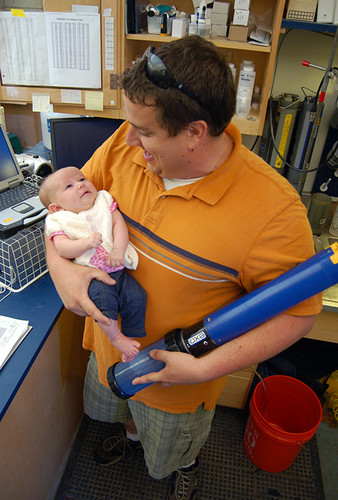The Wrack
The Wrack is the Wells Reserve blog, our collective logbook on the web.
The Wrack is the Wells Reserve blog, our collective logbook on the web.

Jeremy Miller embraces the long view. His projects depend on it. As lead technician for our system-wide monitoring program (SWMP), as state coordinator for monitoring marine invasives (MIMIC), and as lead scientist on the reserve’s larval fish study, Jeremy adds pieces to puzzles without predefined shape. He knows that patterns begin to emerge only after years of methodical, meticulous data collection.
Jeremy thinks back to his 2003 roots at the reserve and wonders where the time has gone. At first an eager intern from the University of New England, he quickly became a fixture. Now, after 10 solid years on SWMP, eight on MIMIC, and seven on baby fish, he tracks the trend lines, investigates the blips, and teases meaning from volumes of data.
When taking over SWMP tasks a decade ago, Jeremy recognized his millions of bits on weather and water would be about the present but for the future. He’s been feeding the longest-running data set on estuarine water quality for half the program’s existence and sees in SWMP an incomparable potential for discovery, with 28 research reserves poised to seek signs of climate change and sea level rise in the best estuary data source available.
As he trained new MIMIC observers this spring, Jeremy figured his volunteer corps had quadrupled and survey sites jumped from four to nine since 2008. In building a marine-invasives baseline for a warming Gulf of Maine the more data the better, he said, explaining to the team that trends take time.
When Jeremy and others started dragging zooplankton nets alongside Wells Harbor docks in 2008, they weren’t sure how long they would be collecting larvae, but knew that accumulating data is the way to understand what’s normal. Last year he heard “you’re off to a good start” from colleagues at a big fisheries conference, accentuating the point that this kind of research is often retrospective.
Jeremy embraces the long view at home, too. His kids depend on him. As dad to 3-year-old Lucas and weeks-old Camille, he awakens every day (and sometimes in the middle of the night) seeking solutions to new, age-old puzzles. In fatherhood, as in science, one’s understanding matures only after years of consistent, dedicated effort.
In both roles, he patiently plugs away, responding to the unplanned and reacting to the unexpected, refining hypotheses and adjusting assumptions. After all the effort, he uses hard-won answers as building blocks, following questions with more questions, too curious and uneasy to rest part way, moving the goal posts of understanding out a little further.
The weeks pass and the points amass — wind speed, water turbidity, tunicate abundance, stickleback size, minutes of quality time, garden berries gobbled by a tot. Jeremy pores over spreadsheets and changes the bed sheets, calibrates data sondes and celebrates days his son or daughter shines in a proud-parent moment.
The diligent data gatherer documents today so tomorrow’s mysteries might be solved. The proud papa prepares his children for whatever shape those puzzles might take.
From Watermark 32(1): Summer 2015